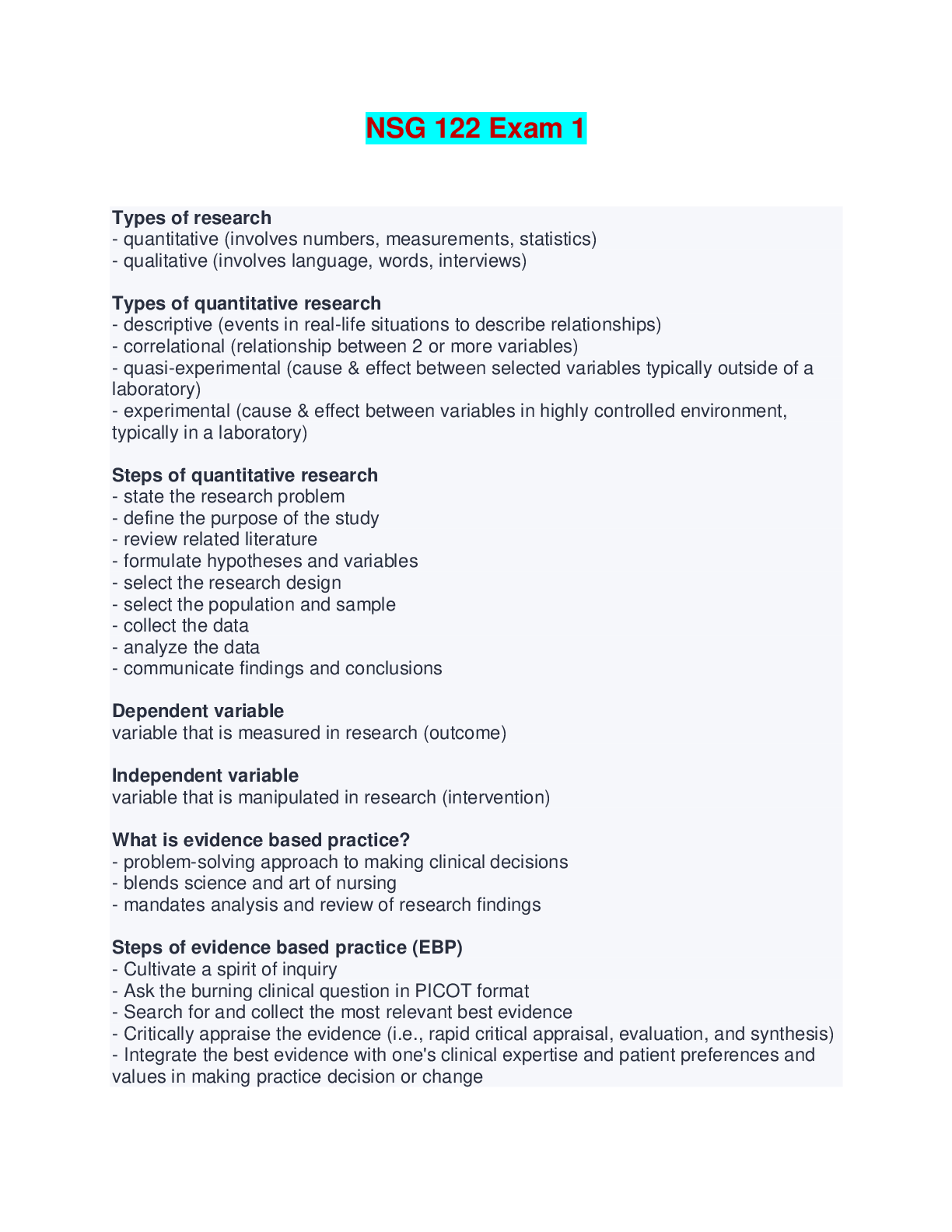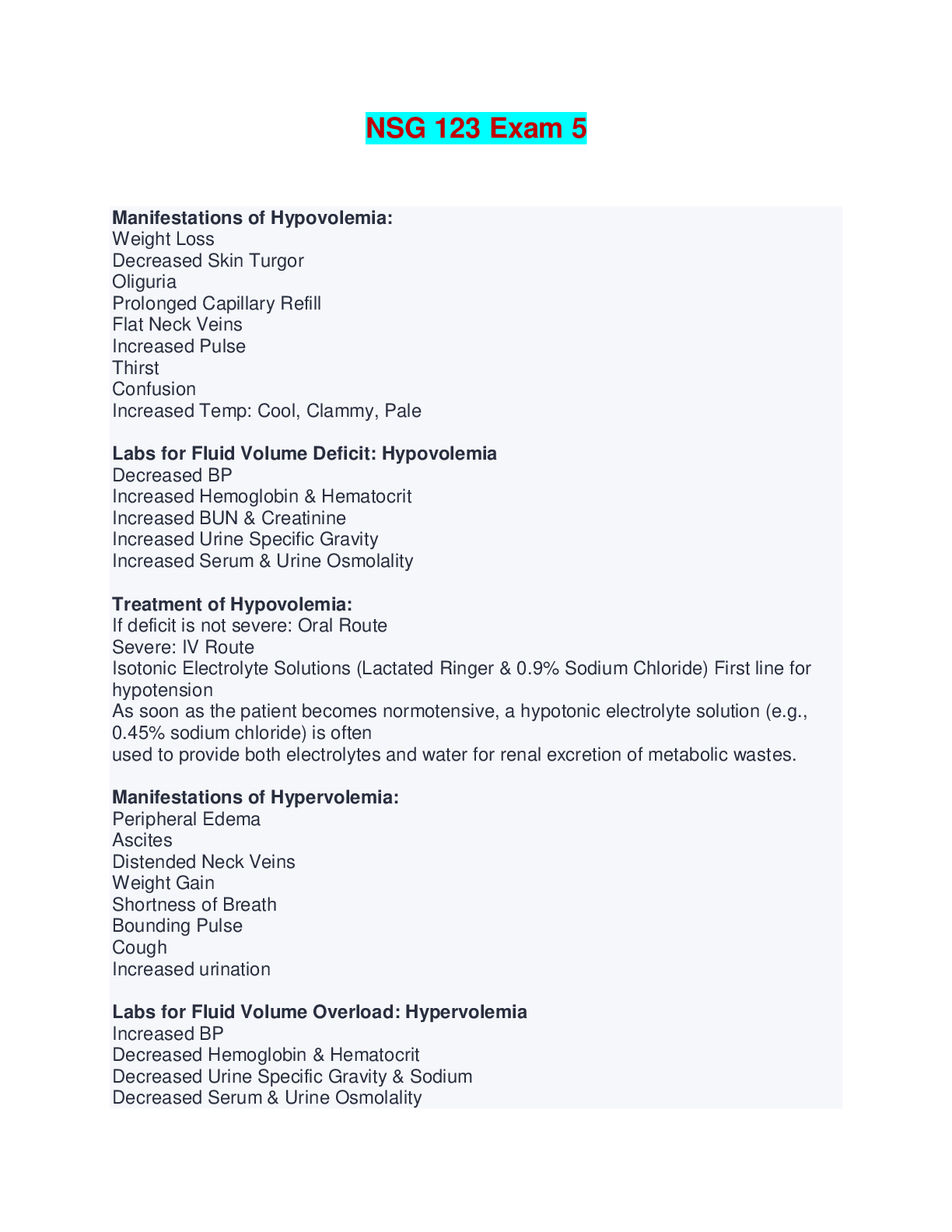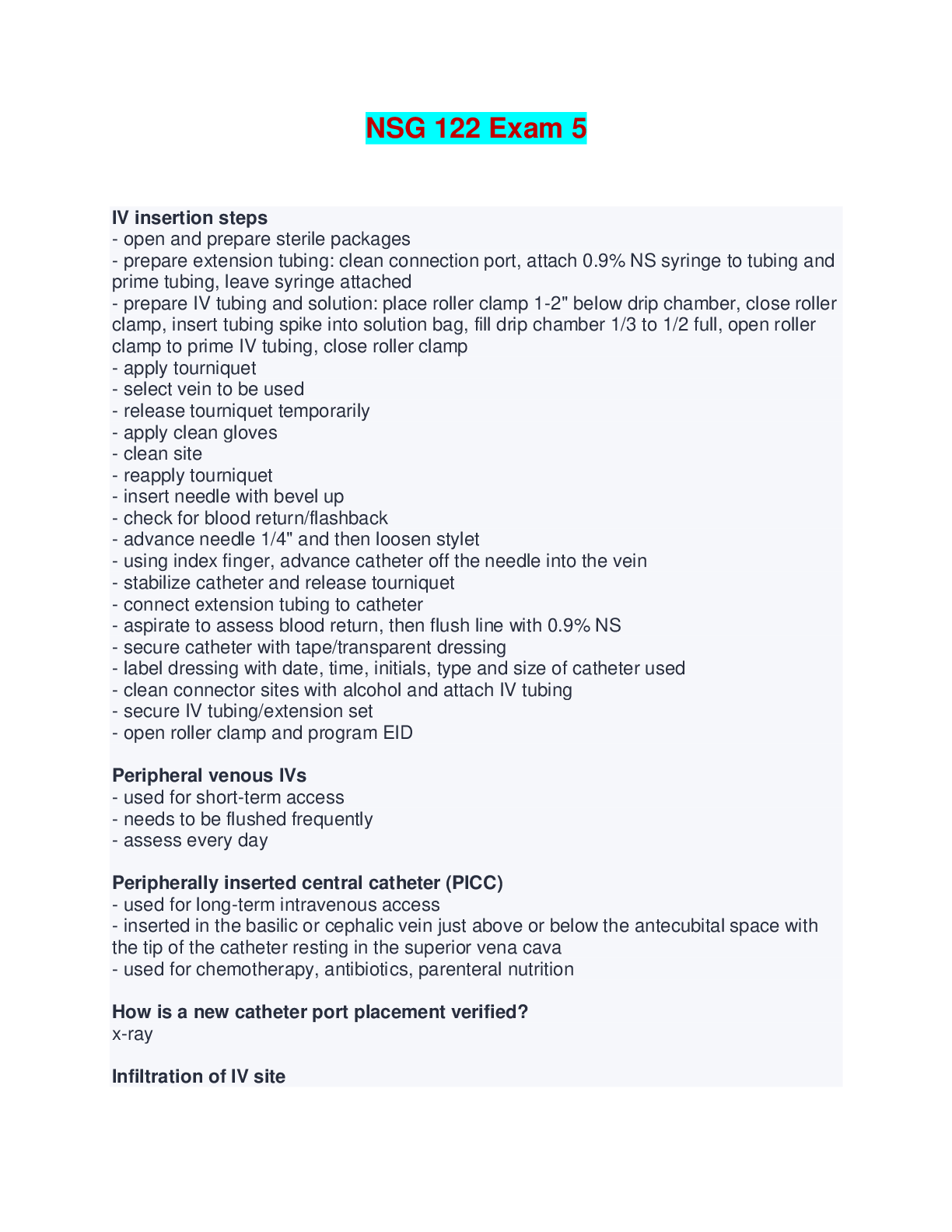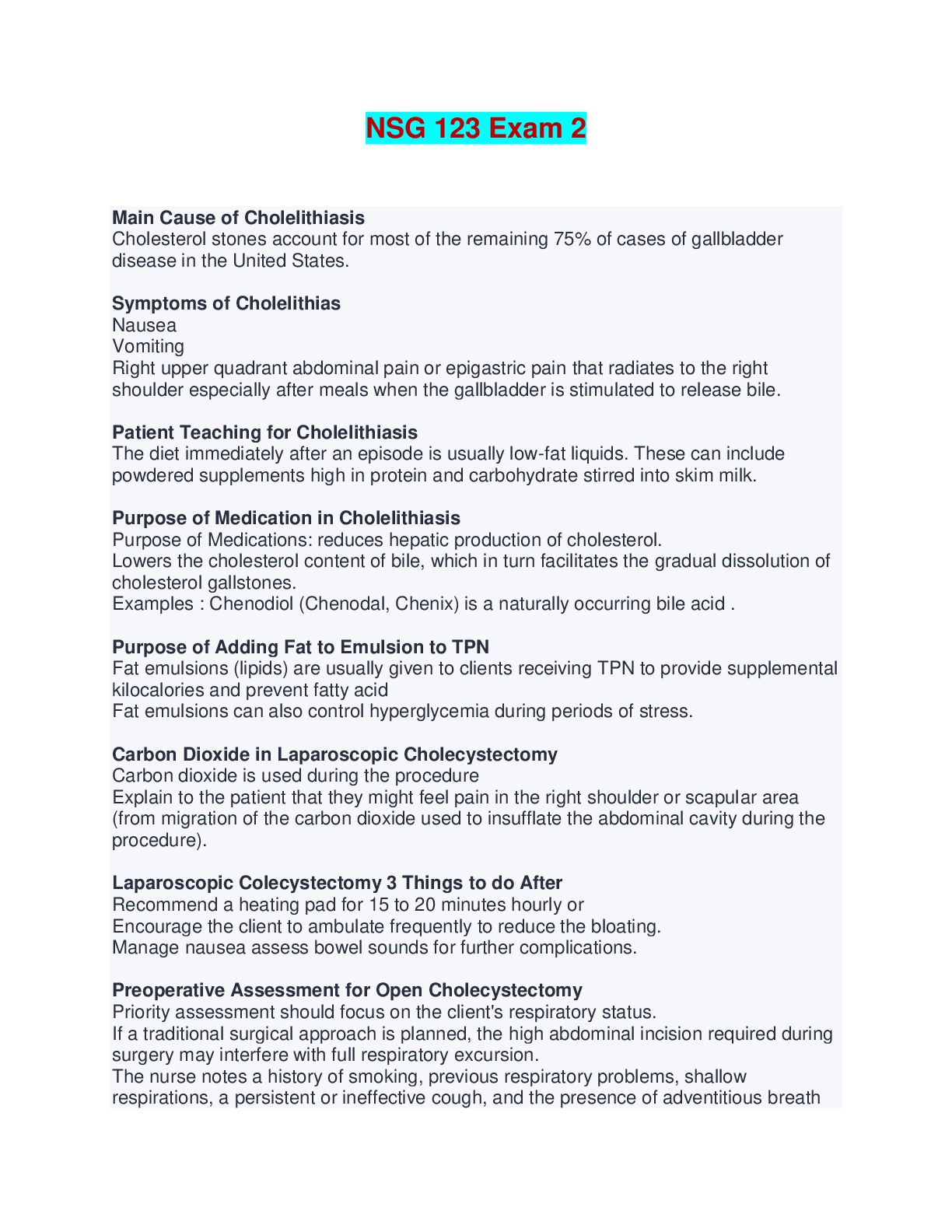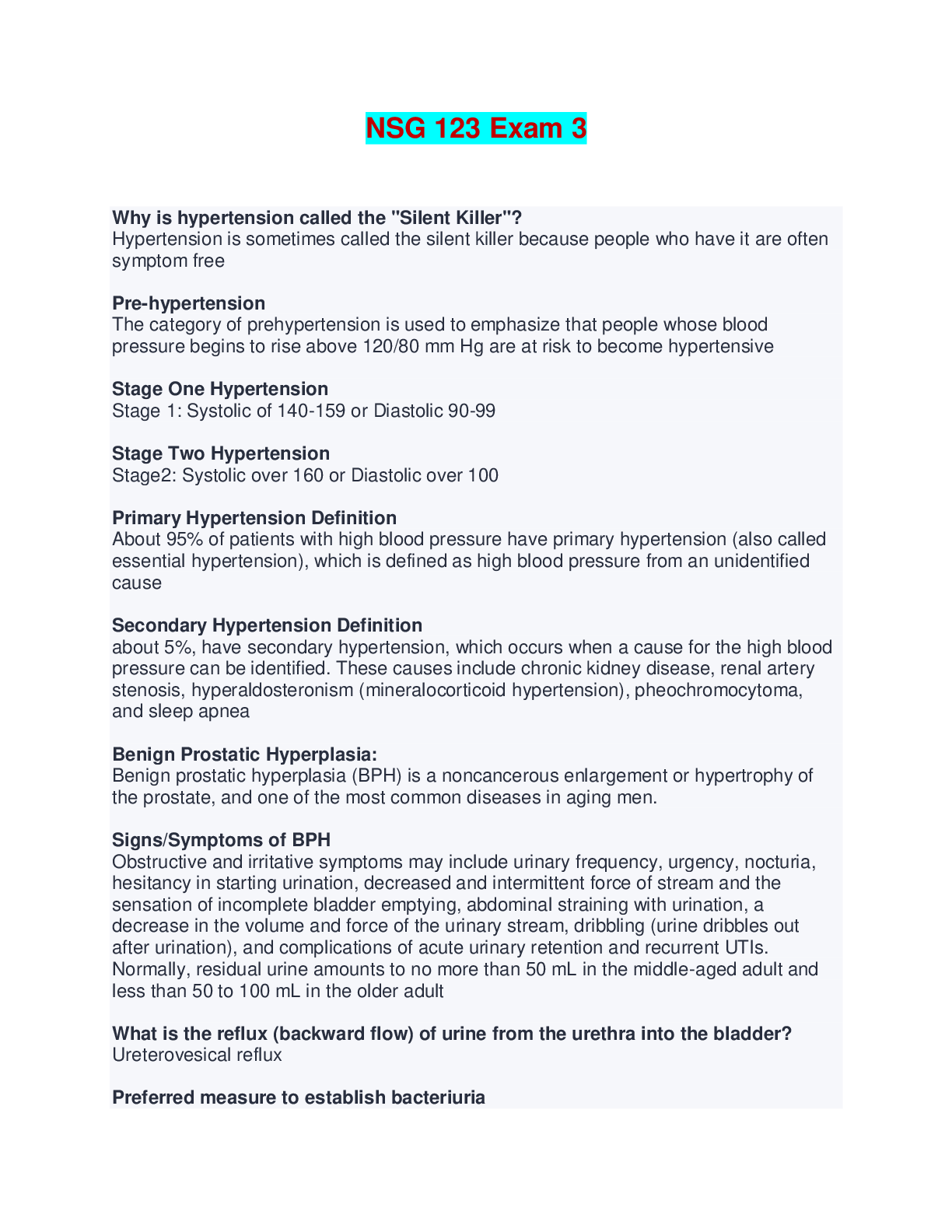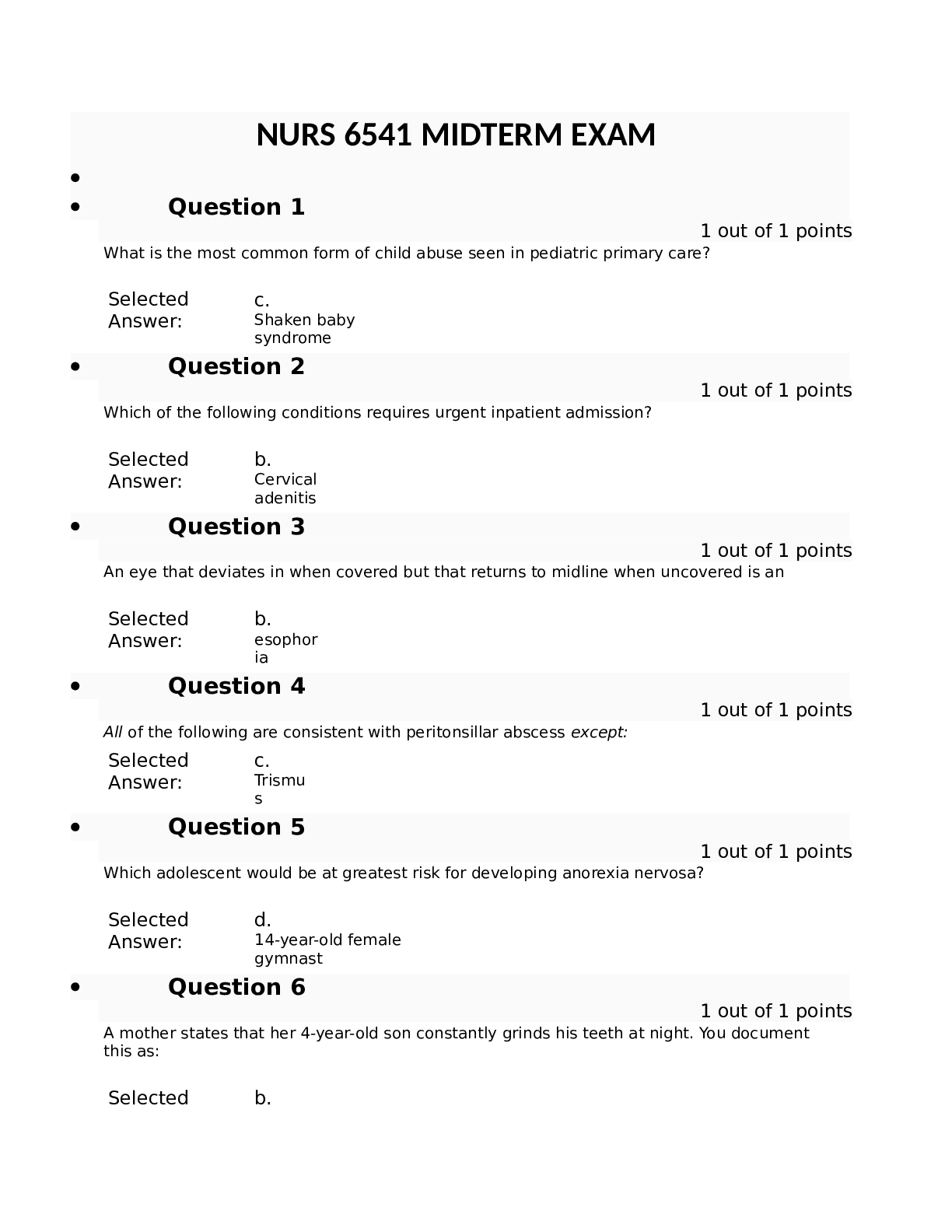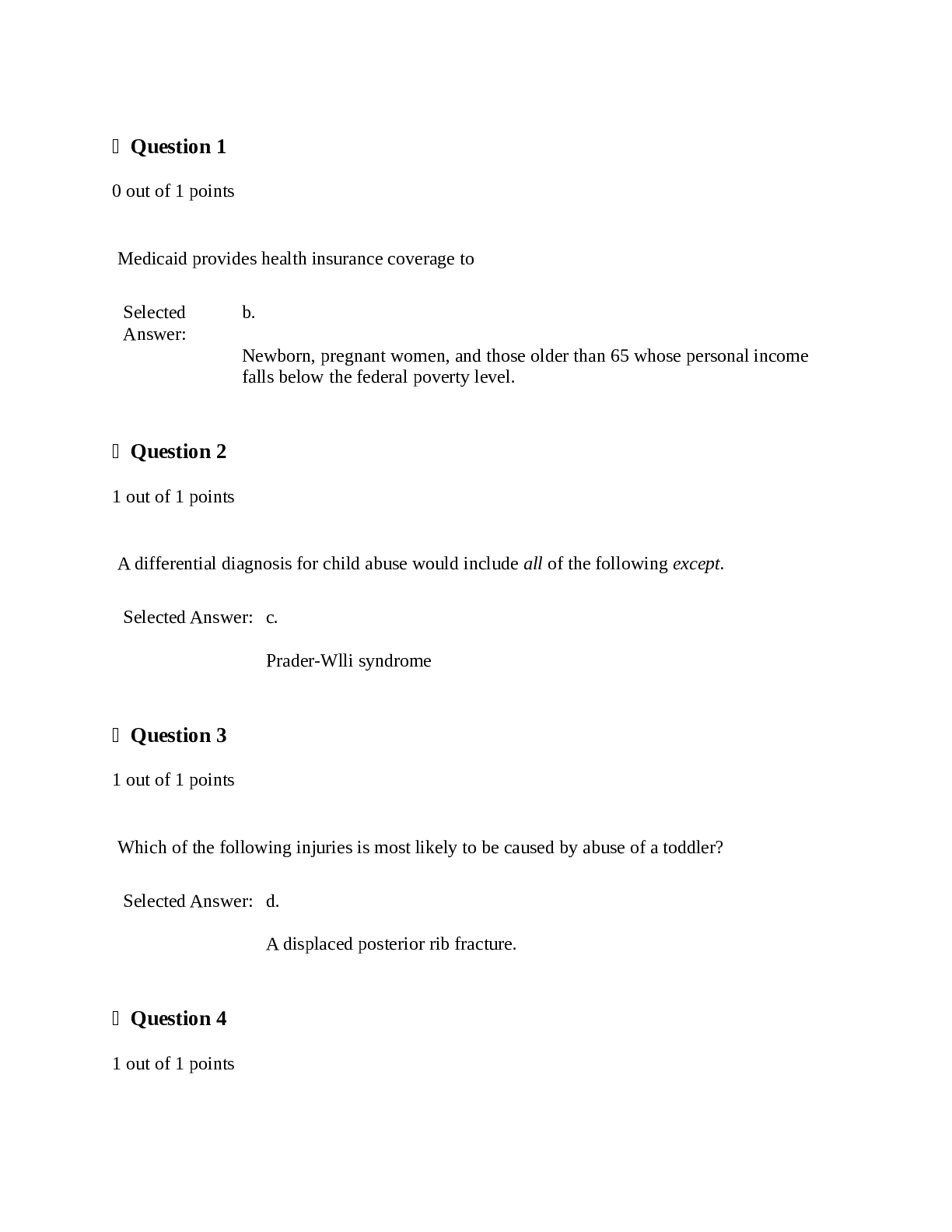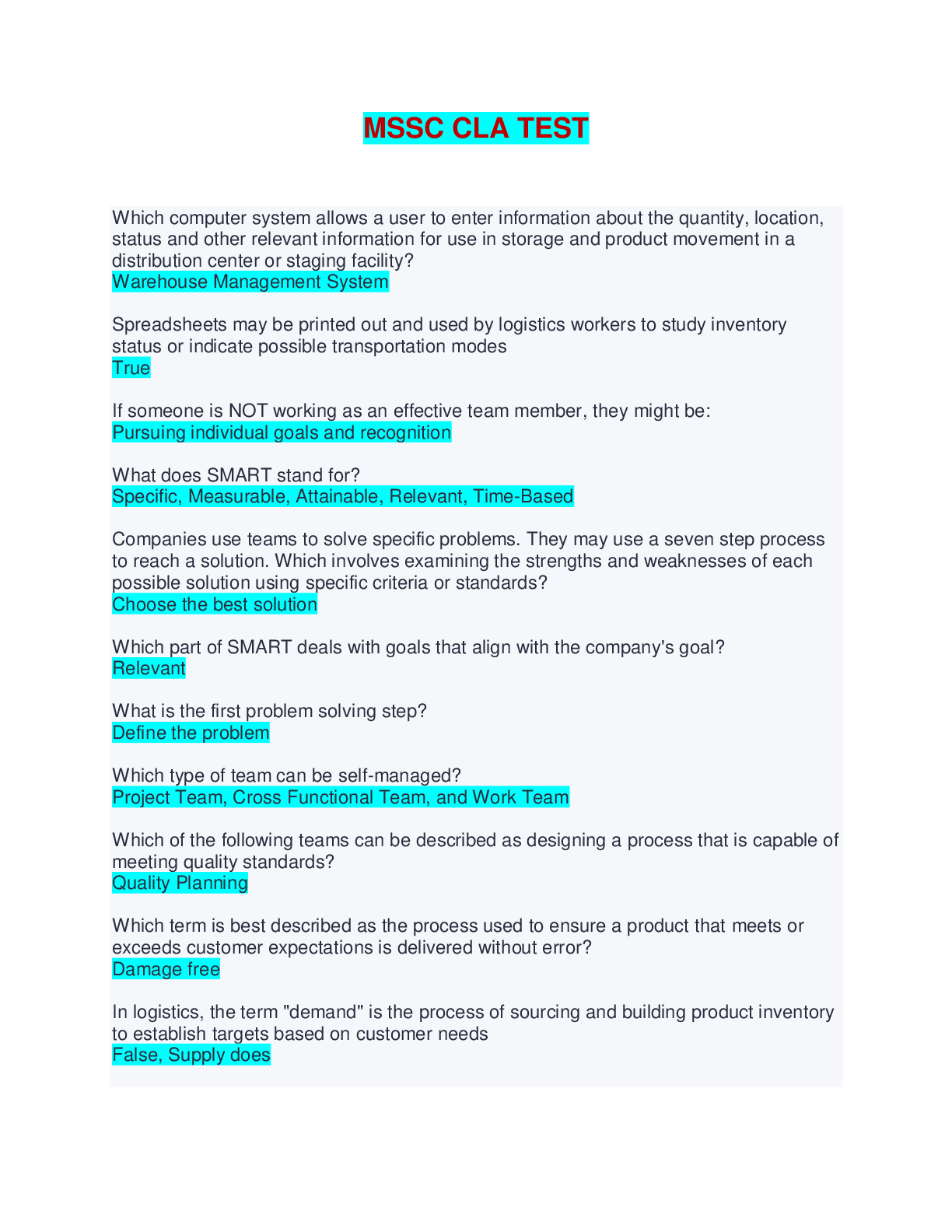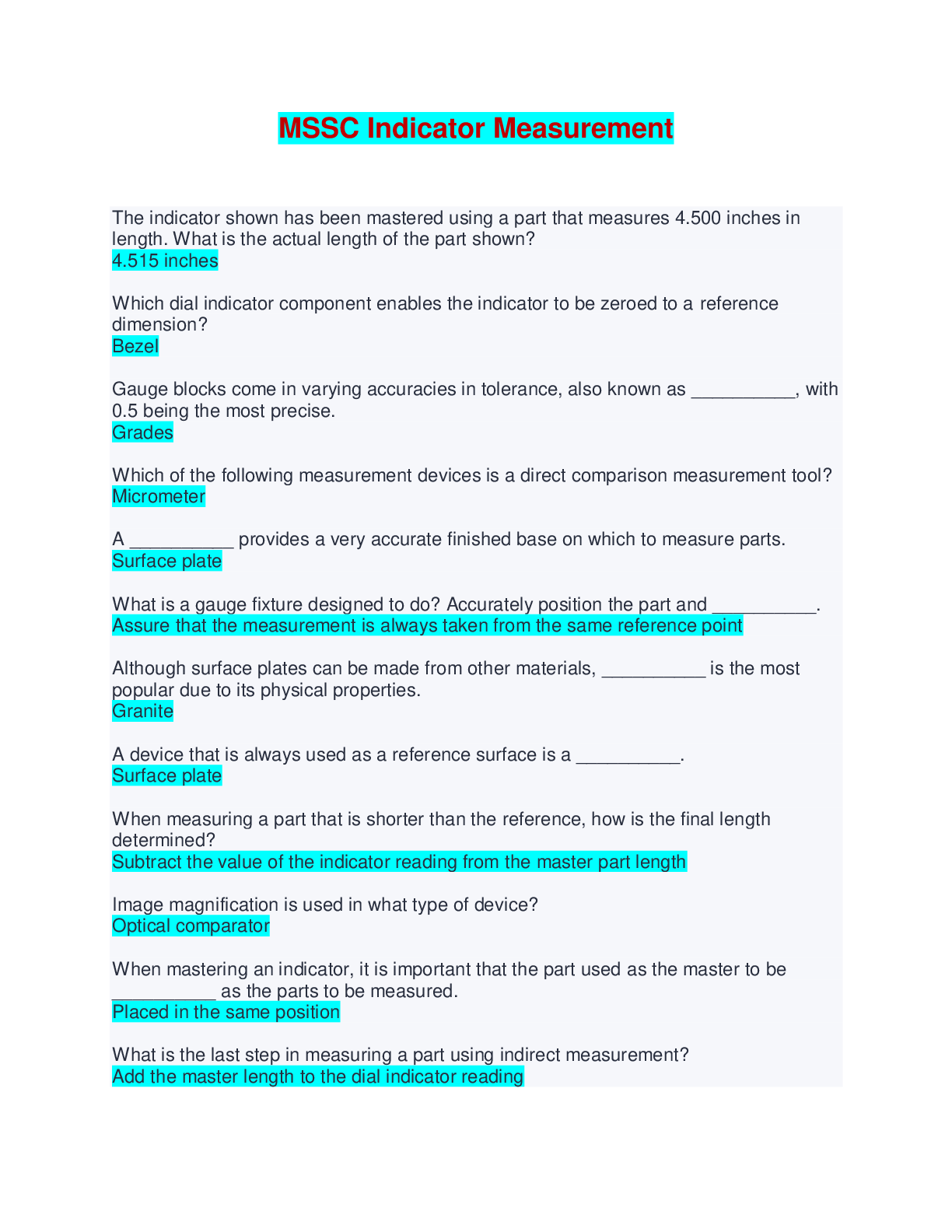EDIS 2310 Quizzes (Ch 1-4) | Questions and Answers
Document Content and Description Below
EDIS 2310 Quizzes (Ch 1-4) | Questions and Answers Julia was diagnosed with bone cancer at the age of six. It was necessary for doctors to amputate her right leg below the knee. According to curren... t terminology, Julia is ________. A. at risk B. challenged C. Handicapped D. impaired Carlos is a high school student who uses a wheelchair. He participates in advanced placement math and science classes and does well in other subjects. He feels awkward in physical education because he is unable to fully participate in sports such as basketball. According to current terminology, Carlos is ________. A. at risk B. challenged C. handicapped D. impaired Which of the following statements about handicaps is NOT true? A. Handicaps may also be a disability if it leads to other problems B. Handicaps pose problems in some environments. C. Handicaps may result from the negative attitudes of others D. Handicaps are evident at birth or shortly after birth Which of the following statements about gender and special education is TRUE? A. Twice as many boys receive special education services. B. Twice as many girls receive special education services. C. Three times as many boys receive special education services. D. An equal number of boys and girls receive special education services. What percentage of the school-age population consists of students with disabilities in special education? A. 2% B. 5% C. 13% D. 30% Which of the following is the largest disability category in special education? A. Autism B. Emotional disturbance C. Intellectual disabilities D. Specific learning disabilities Which of the following reflects the number of students affected with a secondary disability? A. 25% B. 10% C. 50% D. 40% Travis is a third grade student with an intellectual disability. He has just been placed in Mrs. Kinard's third grade class. Students in his class are learning their multiplication facts. Travis is eager to participate in class but instead of allowing Travis to do the same activity as the other students, Mrs. Kinard gives him a coloring worksheet that she obtained from a colleague who teaches kindergarten. Which of the disadvantages of labeling is exemplified by her actions? A. The label is being used to explain his behavior. B. The label has contributed to the expenditure of greater amounts of money. C. The label has caused her to ridicule and reject Travis. D. The label has caused her to have lower expectations and apply different treatments. PARC v. Commonwealth of Pennsylvania (1972) granted a free appropriate public education to ________. A. all students with disabilities B. students with intellectual disabilities C. students with speech and language impairments D. students who were previously deemed unable to benefit from instruction Which principle of IDEA states that no child with a disability can be excluded from a free appropriate public education? A. Zero reject B. Due process C. Mainstreaming D. Full inclusion Hector and his family came to the United States from Cuba last year. Hector speaks only Spanish and seems unable to learn English despite extended help from an ELL teacher. He is failing all subjects in second grade except for Art and P.E. He was recently evaluated for the possibility of an intellectual disability. The school psychologist administered an intelligence test in Spanish. Scores indicate that Hector has significant cognitive delays. Based on the findings, the IEP team is recommending that Hector receive special education services as a student with an intellectual disability. Did Hector receive a nondiscriminatory evaluation as required by IDEA? A. No; only one test was administered. B. No; the psychologist was a stranger to Hector. C. Yes; the testing was done in Hector's home language. D. Yes; the IEP team recommended that Hector receive services. All of the following are examples of related services except ________. A. therapeutic recreation services B. transportation to scheduled doctor visits C. speech and language services to prevent communicative problems D. orientation and mobility services for students who are blind or partially sighted. Amelia is a student with autism who does not speak. Instead she types what she wants to say into a device that converts the text to speech. The device helps Amelia to express her desires and needs. This is an example of ________. A. assistive technology B. an instructional strategy C. interdisciplinary services D. universal design for learning Which of the following court cases sought extended school year services for students with disabilities who regressed during usual school breaks? A. Brown v. Board of Education (1954) B. Armstrong v. Kline (1979) C. Stuart v. Nappi (1978) D. Timothy W. v. Rochester School District (1989) Which of the following court rulings declared that school districts could not be compelled to provide costly related services if a student with a disability made adequate progress in general education without those services? A. Honig v. Doe B. Stuart v. Nappi C. Armstrong v. Kline D. Board of Education of the Hendrick Hudson Central School District v. Rowley According to the IDEA amendments of 1997 a manifestation determination hearing must be conducted ________. A. each time a student with a disability is suspended B. only when a student with a disability is recommended for expulsion C. when a student with a disability has been suspended in excess of 10 days D. when a student has a suspension for at least a school week (5 days) Isaac is a student with a disability who belongs to a neighborhood gang. He is involved in an argument with another student in math class. Later that night, Isaac attends a school sponsored football game. Other students report that Isaac has a gun and is threatening to shoot the student he argued with earlier. Isaac is removed from the football game by authorities. Members of the IEP team decide to place Isaac at an alternative school for 45 days. Were Isaac's rights violated? A. No; the IEP made the decision to remove Isaac so multiple perspectives were considered. B. No; schools have the right to remove students who bring weapons to school to an interim alternative placement C. Yes; a student with a disability cannot be removed for more than 10 days. D. Yes; a manifestation determination hearing must be conducted before Isaac can be removed. Which of the following is not defined as a major life activity in the Americans with Disabilities Act? A. Caring for oneself B. Enjoying leisure time C. Communicating D. Working Which of the following is a characteristic of primary prevention? A. It is designed to eliminate the effects of risk factors on those so exposed. B. It is designed to reduce the number of new cases of disabilities. C. It is designed for people who are already affected by a problem. D. It is designed to prevent the effects of a disability from worsening. Maurice has cerebral palsy and is physically unable to speak. His teacher helps him to learn to use a communication board. What type of intervention is this. A. Compensatory B. Preventive C. Rehabilitative D. Remedial Chapter 2 Quiz Which of the following is NOT a step in prereferral intervention? A. Teacher or parent reports concern with child's progress. B. Parents are notified. C. Parent consent for testing and evaluation is obtained. D. Intervention assistance teams help plan and implement interventions. All of the following are typically members of early intervening assistance team except ________. A. general education teachers B. special education teachers C. the school nurse D. the student's parents RTI is designed for all of the following purposes except ________. A. determining whether the child is a child with a disability B. providing IEP teams with valuable baseline data for planning C. providing immediate instructional and/or behavioral assistance D. reducing the frequency of special education placement Which of the following is NOT involved in RTI? A. Universal screening B. Continuous progress monitoring C. Multifactored evaluation D. Several tiers of intensive intervention before referral After parental consent has been obtained, school districts must complete the evaluation process for a student suspected of having a disability within ________. A. 30 days B. 45 days C. 60 days D. 90 days Which of the following is NOT a reason to involve students in the development and implementation of their IEPs? A. It leads to the development of more meaningful IEPs. B. It is a requirement of ADA that students are involved in developing their IEPs. C. It provides an opportunity for students to practice self-determination skills. D. It is a requirement of IDEA that students be present whenever appropriate. All of the following contribute to disproportionate representation of diverse students in special education except ________. A. biased referrals B. inaccurate assessment C. ineffective instructional practices D. inconsistent parental involvement In program planning, the evaluation team determines all of the following except ________. A. learning goals and objectives B. causation of the disability C. providers of special education and related services D. frequency of specialized instruction and related services Which of the following best represents the concept of teaming? A. A group of teachers share bus duty. B. A paraeducator designs a bulletin board for a special educator. C. A special educator provides a list of possible accommodations for a student to a general educator. D. A special educator and a general educator design assignments and assessments for a student and meet to share results. Mrs. Jonas, a speech therapist, Mr. Dodds, a physical therapist, and Mrs. Anthony, a special education teacher, work independently to provide services to Jasmine, a student with cerebral palsy. Mrs. Jonas addresses Jasmine's articulation problems. Mr. Dodds focuses on helping Jasmine walk with braces, and Mrs. Anthony works on Jasmine's reading and math goals. Which type of team is described in this scenario? A. Interdisciplinary B. Intradisciplinary C. Multidisciplinary D. Transdisciplinary Mrs. Watkins, a fifth grade teacher, and Mrs. Dubois, a special educator, want to begin teaching a unit on fractions. They want to keep group size small so they each teach the same lesson to an equal number of students. Which model of co-teaching is described in this scenario? A. Alternative teaching B. Parallel teaching C. Station teaching D. Team teaching Successful co-teaching requires all of the following excepT ________. A. flexibility B. a sense of humor C. meticulous planning D. open communication Which of the following statements about an IEP is inaccurate? A. An IEP is a measure of accountability. B. A school district is legally obligated to provide the services described in the IEP. C. Teachers and school districts can be prosecuted if a student does not meet the goals in the IEP. D. Schools must be able to document that they made a conscientious effort to achieve the goals in the IEP. Which of the following is an example of a measurable annual goal? A. By the end of the school year, Jason will learn to enjoy reading. B. By May of 2012, Elizabeth will improve her anger when teased. C. By the end of the school year, Mary Ellen will become independent in using study skills. D. By the end of the school year, Erin will read a third grade level reading selection with 95% accuracy. Recent studies of actual IEPs indicate that ________ A. they are data based and creative B. they are often useless to parents and students C. they have improved greatly over the past 20 years D. they represent the best of educational interventions To be sure that students with disabilities receive the highest quality of instruction, teachers are required to use ________. A. curriculum-based assessment B. evidence-based practices C. peer-initiated strategies D. small-group instruction Which of the following statements about least restrictive environment is TRUE? A. The LRE may change over time. B. The LRE is the setting that is the most diverse. C. The LRE is the resource room for most students. D. The LRE is determined by the disability category. IDEA requires that an individualized education plan be developed for all students with disabilities between the ages of ________ A. birth to 21 B. 3 to 18 C. 3 to 21 D. 6 to 21 Which of the following statements about inclusion is TRUE? A. Most parents of students with disabilities support inclusion. B. Most parents of children with severe disabilities oppose inclusion. C. Many parents of children with disabilities support inclusion and others oppose it. D. Many parents of children with disabilities support inclusion in theory but most oppose it in practice. Which is NOT a classwide peer tutoring model derived from research in inclusive classrooms? A. The Ohio State University model B. Peer Assisted Learning Strategies C. Juniper Gardens Children's Project D. The Detroit University Peer Project Chapter 3 Quiz Which of the following statements about parent involvement and special education is TRUE? A. Parent involvement is an essential element of special education. B. Parent involvement is generally discouraged by special educators. C. Parents spend an exorbitant amount of time communicating with special educators. D. Parents generally perceive special educators as experts and are hesitant to become involved in educational decisions. Which of the following is the least powerful argument for family involvement in special education? A. Family members can teach students new skills. B. Family members need to feel that they are important. C. Family members must live with the outcomes of decisions made by IEP teams. D. Educational outcomes are more likely to be significant if family members are involved. According to research, initial reactions of parents who learn that their child has a disability are generally ________ A. feelings of shock, denial and disbelief B. alternating feelings of anger, guilt and depression C. feelings of shame, rejection of the child, and overprotectiveness D. feelings of love and appreciation for the positive aspects of family life Common feelings of siblings of children with disabilities include all of the following except ________. A. feelings of being left out B. uneasiness about the reaction of friends C. concerns about the cause of the disability D. fear that they will be rejected by their sibling with disabilities Principles for effective communication between parents and educators include all of the following except ________. A. passive listening B. staying focused C. effective questioning D. accepting parents' statements Which of the following is an example of an open-ended question? A. Does Melvin like school? B. What did Katy name her dog? C. Will Jason walk or ride the bus to school? D. What does Jasmine like to do on the weekend? Mark is a student with autism. Mrs. Tozzi, a fifth grade teacher, is having a conference with his parents. She begins by welcoming them. She asks his parents if he is experiencing problems with his homework and invites them to explain how autism is likely to affect his academic and social skills. Finally, she asks them if Mark is having any other challenges that she may not be aware of. Was Mrs. Tozzi engaging in effective questioning? A. Yes; she asked open-ended questions. B. Yes; she valued the input of his parents. C. No; she focused mainly on problems and deficits. D. No; she did not allow them to keep family information private. Which of the following professional behaviors can be a roadblock to communication? A. Negotiating IEP goals B. Reflecting on communication C. Explaining steps to help children D. Treating parents as if needing counseling [Show More]
Last updated: 3 months ago
Preview 4 out of 16 pages

Loading document previews ...
Buy this document to get the full access instantly
Instant Download Access after purchase
Buy NowInstant download
We Accept:

Also available in bundle (1)

EDIS 2310 QUIZZES (CH 1-4) AND FINAL EXAM BUNDLE
EDIS 2310 QUIZZES (CH 1-4) AND FINAL EXAM BUNDLE
By Ajay25 3 months ago
$18
2
Reviews( 0 )
$15.00
Can't find what you want? Try our AI powered Search
Document information
Connected school, study & course
About the document
Uploaded On
Feb 26, 2025
Number of pages
16
Written in
Additional information
This document has been written for:
Uploaded
Feb 26, 2025
Downloads
0
Views
15

